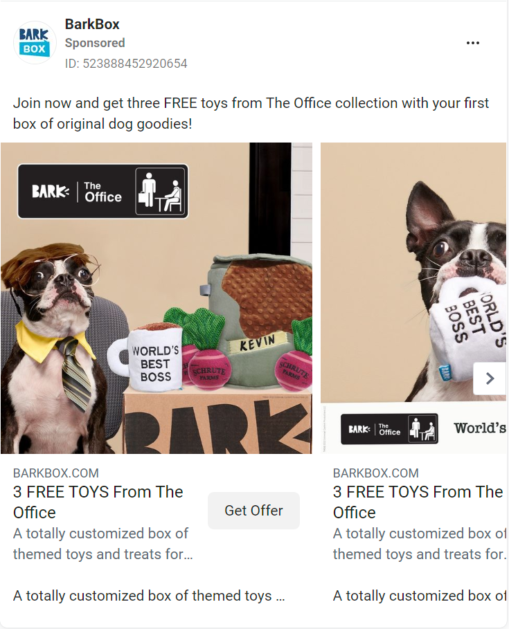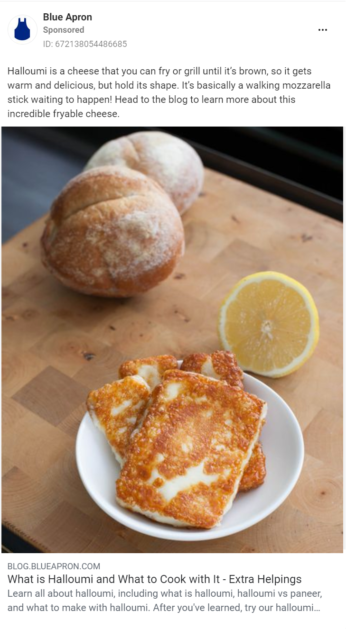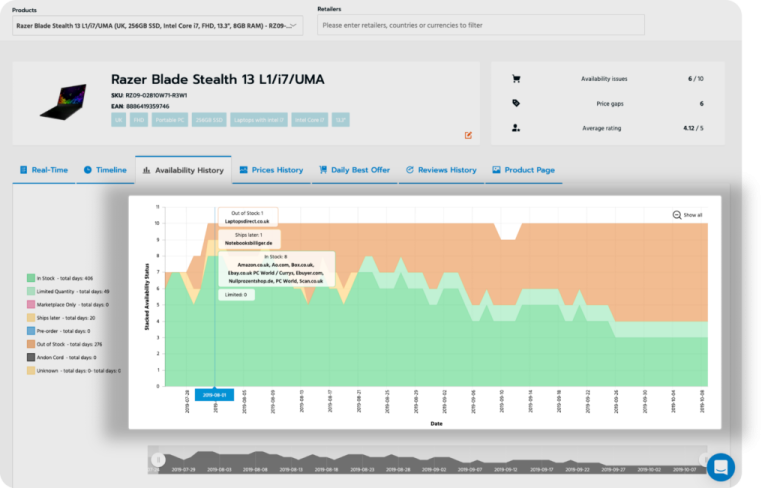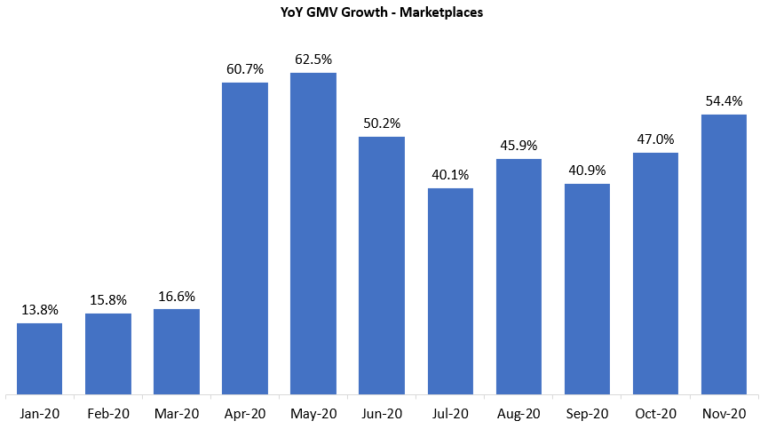Ecommerce advertising is a huge industry and constantly evolving alongside social and technological changes. This makes it hard to stay up to date on current trends and best practices, especially while trying to run a business.
The bright side is that you don’t have to be an expert at every facet of ecommerce advertising to make use of it. There are tons of different tactics to try, some easier than others, and you can just start with one or two while you learn about others.

In this guide, we will explain exactly what ecommerce advertising is, give some tips and suggestions, including social network strategies, as well as some real-life examples you can use for inspiration.
What Is Ecommerce Advertising?
The Cambridge Academic Content Dictionary defines advertising as “a paid notice that tells people about a product or service.” Similarly, Dictionary.com defines advertising as “a paid announcement, as of goods for sale, in newspapers or magazines, on radio or television, or on the internet.” The key piece of these definitions is the word “paid.”
There are many types of paid ads used by ecommerce companies to promote their brand and products, but these make up only a fraction of the overall ecommerce marketing strategies out there. Common examples of ecommerce ads include banner ads placed on other websites, video ads such as commercials or YouTube bumper ads, and sponsored social media posts.
In each case, the method involves a company paying for strategic content placement to raise brand awareness, promote their products, or announce sales. Ecommerce advertising can be an extremely effective way to attract new customers.
Advertising for Ecommerce With Google
Google is the most popular website and search engine ever to exist. As such, it provides many ways for ecommerce companies to advertise, such as Google Shopping Ads. Here are the most prominent types of Google ads.
Google Text Ads
You often see text ads at the top of Google search results. There are often a couple at the top and bottom of each search engine results page with the word “Ad” bolded at the beginning. These are Google text ads, essentially paid results or search ads.

These simple but effective PPC ads blend in with the high-ranking organic search results to put you right in the action. Well-designed entries with the right keywords can win you traffic in high quantities and quality.
Google Display Ads
The Google Display Network encompasses over two million websites. These sites are prime real estate for displaying the ads you commonly see in the margins of your favorite websites or sometimes tucked in between paragraphs.

These are called display ads, which are usually traditional advertising images that promote ecommerce sales or other standard marketing. Google can help you find the best sites for your display ads to be shown so that those with similar interests will encounter your advertisement.
General Display Ads
General display ads outside of the Google Display Network can also be effective for attracting new website visitors. However, they generally lack the automation and targeting features Google provides. Still, general display ads are a tried-and-true strategy if you want to raise brand awareness by getting in front of new users.
Advertising for Ecommerce With Facebook
With three billion active users, Facebook is one of the best platforms for ecommerce advertising. You may think this is just paying for sponsored posts that pop up in users’ feeds, but there are actually many ways to advertise on Facebook. Knowing which option is best for your brand and target customers can significantly impact your ad campaign’s profitability.
Photo Ads

Photo ads are probably what you think of when you imagine a sponsored Facebook post. They look more or less like any other post, with an image sandwiched between text and the like, comment, and share buttons. These are basic but effective ads that blend in with the surrounding content in users’ feeds.
Carousel Ads

Carousel ads are similar to photo ads but allow you to showcase up to ten images. Users simply swipe sideways to rotate the carousel, revealing the next or previous image. These ads are perfect for ecommerce product collections.
Story Ads
Facebook Stories is a popular new feature that lends itself well to ads. These can be in the form of still images or videos and will pop up between stories shared by others. Again, these fit in well with the surrounding content and are good for reaching new audiences.
Video Ads
Video ads pop up like images or other posts in Facebook feeds, but obviously, they include video and sound. Especially since Facebook has autoplay videos now, many scrollers will stop to watch what is going on, making these ads great for raising brand awareness.
Instant Experience Ads
Instant Experience ads offer a range of cutting-edge features for adding a little flair to your ads. These can be fullscreen, interactive, or even include products and videos. If you’re looking for something a little more advanced than the standard option, check out Instant Experiences.
Collection Ads

Collection ads are perfect for just about any store. They consist of a large central image with additional options below. If you succeed in catching a scroller’s interest with the first images, they might keep going and click through to your website.
How to Target Your Facebook Audience
Facebook collects a lot of data about its users, meaning there are a lot of customization options available to advertisers. Want to serve an ad to male users between the ages of 35 and 50 who are fans of rock music? You can do that. Also, consider which types of ad formats will best suit your content. Don’t be afraid to experiment and mix it up to find out what works best!
Advertising for Ecommerce With Instagram
Though only the fourth largest social media platform, Instagram is the second most popular for B2C marketers by a significant margin. The visual nature of Instagram makes it perfect for showcasing ecommerce products, while different features and integrations streamline the process from attraction to checkout. Here are the best Instagram ad types for ecommerce.
Reel Ads
Instagram Reels borrow heavily from the short video style of TikTok. Reels provide a rabbit hole of infinite aggregated content, and since more than 90% of Instagram users watch video weekly, it is easy to slip in some ads. Again, these are usually short-form videos only a matter of seconds in length.
Story Ads
Instagram Stories are much like Facebook Stories, consisting of short videos and images. This content is only available for 24 hours and is intended for page followers, meaning it is a better avenue for connecting with your existing audience than attracting new shoppers.
Post Ads
Sponsored posts on Instagram are very similar to Facebook ads, showing up in the feed among regular content. These can be images or videos and are great for growing brand awareness. You can even decide who sees your ads for a better return on ad spend.
Explore Ads

The Instagram Explore tab offers a mix of content for users who want to experience something new. This could be pictures, videos, or even shopping. If you are looking to connect with potential new customers who are showing a little curiosity, try Explore ads.
IGTV
While Instagram primarily focuses on pictures and short videos, some creators wanted an outlet for long-form content. Enter Instagram TV. Not unlike YouTube, IGTV is home to all sorts of video content. If you are looking for a new place to share video ads, or want to recycle your YouTube advertising, consider IGTV.,
Instagram Shopping
Instagram Shopping is a place where customers can connect with businesses showcasing their favorite products. Since these IG users are already in the shopping mood, ecommerce advertisements can be very effective here. Ad tiles are dropped in among regular Shopping tab content, putting them in front of ripe customers.
Instagram Targeting
Since Meta owns both Facebook and Instagram, the targeting options for ads are just as robust. You don’t have to just let your ads run wild on Instagram, popping up on any feed. Target IG users with the demographics and interests most aligned with your brand for better results.
Advertising for Ecommerce With Snapchat
Snapchat is a less obvious but surprisingly popular advertising solution. Like Instagram, it owes some of its success to being visually oriented, making it easy to create eye-catching ads. Images and videos can both be used in a number of ways, as can interactive app features.
Augmented Reality and Interactive Ads
Snapchat was one of the earliest big apps to really lean into AR and interactivity for advertising. It started with fun features like filters and other camera gimmicks before evolving to adopt AR. Snapchat requires a little more creativity than other social media platforms regarding advertising, so interactive ads and augmented reality were worthwhile experiments.
Commercials

Snapchat Stories was an obvious place to add ads, similar to how they are used on Facebook, Instagram, and TikTok. Short video and image ads are inserted into the users’ Stories playlist for brief, minimally invasive advertising.
Filters
Filters started as a fun way for users to modify their pictures and selfies. It wasn’t long before some savvy ecommerce brands saw potential there. By creating filters that relate to their business, brands could get Snapchat users to make and share user-generated content that essentially advertises for the company.
Ecommerce Advertising Strategies
Advertising is as broad and varied as the ecommerce industry. It is easy to get tunnel vision focusing on a few ideas or tactics, and losing sight of the big picture. Below are some important concepts to remember when working on your ecommerce advertising strategy.
Mobile-first
More consumers are now using mobile devices for ecommerce than traditional computer setups. That means, if anything, your ecommerce advertising should be more focused on mobile users. This includes marketing channels as well as website design and user experience.
Personalization
Personalization can mean a lot of things. In the world of ecommerce, advertising usually refers to using user search habits to serve strategic ads. Rather than just showing the same ad for every person, regardless of age, interests, or location, you can create different ad variations targeted at different customer personas and deliver the appropriate version to each subject.
Post-click optimization
Where a lot of ecommerce advertising strategies fall short is in the follow-through. Advertising campaigns are incomplete if they stop at click-through rates, delivering potential customers to a website and abandoning them there. What happens after they click on the ad is crucial. Customers should arrive at a targeted landing page, product page, or even pre-filled shopping cart for a frictionless conversion.
Conversion rate optimization
For many ecommerce stores, ads are the best way to drive traffic to their website. However, all the traffic in the world means nothing if no one is converting. Again, the ad itself is only one piece of the puzzle. An effective ecommerce advertising strategy needs high-traffic ads combined with solid average conversion rates to be successful.
Omnichannel
Omnichannel marketing is the concept that all of your different customer interactions should be a concerted effort. If a customer has visited your website in the past, that should trigger different ads than a fresh face. A customer who has purchased from you should be on a different email list than new leads. Depending how customers react to email marketing (whether they opened them or not, for example) should affect which social media advertising they see. The goal of omnichannel marketing is for everything to work in sync for optimal results.
Artificial intelligence
AI technology is rapidly advancing, and many advertisers are finding ways to use it. One of the biggest strengths of AI is the ability to make decisions based on large amounts of data quickly. This goes beyond a simple algorithm and can be helpful for things like omnichannel marketing, where individual user history and other complex factors determine which ad should be served. Understanding large quantities of data is made easier through AI.
Augmented Reality
While there aren’t many ways advertising is taking advantage of AR technology just yet, some companies have developed apps that leverage this nascent tech. For example, the Ikea app lets you visualize how a piece of furniture would look in your room with your phone camera. It will be exciting to see how AR technology integrates with ecommerce advertising in the coming years.
Targeting and retargeting on social platforms
Retargeting ads are one of the most effective forms of personalization. Essentially, retargeting finds prospective customers who have shown interest in a product or service in the past (usually via their browsing history) in order to reach more qualified targets. Don’t waste your advertising budget throwing ads at anyone and everyone; target custom audiences with a higher chance of converting.
Influencer Marketing
Influencer marketing is a relatively new but powerful strategy for reaching new target audiences. The concept is simple: partner with an influencer who has an active following related to your niche and engage with their audience. How this partnership works is up to you, but it can really amplify typical advertising and marketing tactics.
Best Examples of Ecommerce Advertising
If you spend time on social media, watch YouTube videos, or see TV commercials, then you’re probably familiar with the following ads. These are four examples of hyper-successful ecommerce advertising campaigns and the brands that launched them.
Dollar Shave Club

Dollar Shave Club was a unique idea when it first joined the subscription box scene. There had been subscription services for many other items, but none quite caught on in the affordable grooming category. Dollar Shave Club effectively uses omnichannel marketing with hilarious video ads, colorful display ads, and effective social media marketing campaigns.
Patagonia

Patagonia sets itself apart as a sporting goods store that cares. Rather than just being a business selling these products, Patagonia positions itself as improving its customers’ quality of life with high-quality, dependable equipment and apparel. The brand also strongly supports environmental activism, a prominent theme in its commercials and other advertising.
BarkBox

BarkBox is another popular subscription service that owes much of its success to effective ecommerce advertising. Monthly boxes full of treats and toys for your dog are an awesome idea. It also makes for easy ad content in the way of pet owners loving on their pups and dogs having a blast with the included products.
Blue Apron

Blue Apron was one of the first big pre-packaged meal services in the internet age. The brand relied heavily on social media ads and referrals, racking up a lot of subscribers quickly. Competing brands like HelloFresh, Plated, and Home Chef quickly popped up, but Blue Apron’s effective DTC video ads have kept them at the front of the pack.
FAQs
Ready to Start Creating Some Ecommerce Ads?
Now that you know more about the many different tactics for ecommerce advertising, you can strike out on your own and make use of them in your marketing plans. Don’t be afraid to experiment, but be conservative with your budget while getting familiar with different methods. Good luck!




